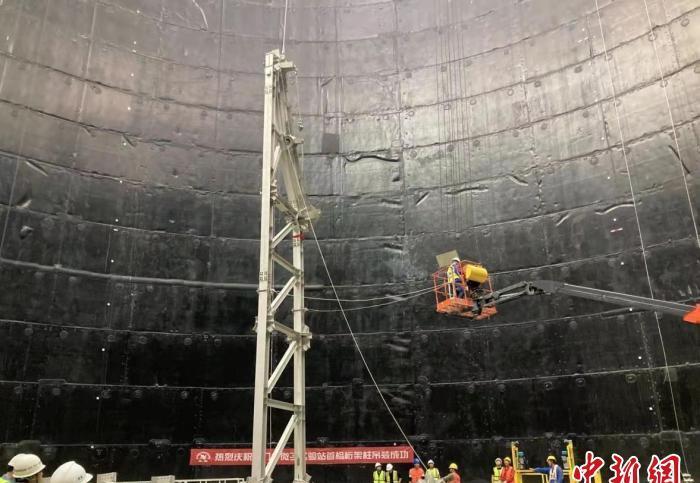
Jiangmen Neutrino Experiment Center detector stainless steel mesh shell main structure of the first support column hoisting site. Photo courtesy of the Institute of High Energy, Chinese Academy of Sciences
Beijing, 27 Jan (China News Network) -- On 27 January, a reporter learned from the Institute of High Energy Physics of the Chinese Academy of Sciences (Institute of High Energy Of the Chinese Academy of Sciences) that the on-site installation of the detector for the Jiangmen Neutrino Experiment, a large scientific device understood by the institute, has recently been in full swing.
The Institute of High Energy of the Chinese Academy of Sciences said that due to the great scientific significance of neutrino research and fierce international competition, in order to complete the installation of the detector as soon as possible, the Jiangmen Neutrino Experimental Construction Project will not stop work during the Spring Festival, and the engineering and technical personnel will continue to install the work on the spot.
A few days ago, the first support column of the main structure of the stainless steel mesh shell of the Detector of Jiangmen Neutrino Experiment Center was successfully hoisted and dropped. The stainless steel mesh shell with a diameter of 41 meters will carry 35.4 meters diameter plexiglass balls, 20,000 tons of liquid scintillators, 20,000 20,000 20-inch photomultiplier tubes, 25,000 3-inch photomultiplier tubes, front-end electronics, cables, anti-magnetic coils, light barriers and many other key components, and the manufacturing accuracy of its structure is very high.
The first support column of the main structure of the stainless steel mesh shell of the Jiangmen Neutrino Experiment Center detector was hoisted and dropped, and the engineering and technical personnel took a group photo to commemorate the occasion. Photo courtesy of the Institute of High Energy, Chinese Academy of Sciences
The stainless steel mesh shell of the Jiangmen Neutrino Experiment Center detector is one of the largest monomer stainless steel main structures in China, which is made of about 900 tons of low-radioactivity background stainless steel material welded into components in the factory and transported to the experimental site through 120,000 sets of high-strength bolts. Since the establishment of the project in 2013, the project team of the Institute of High Energy of the Chinese Academy of Sciences has worked with design and production enterprises to overcome many process and technical problems: solve the problem of welding deformation of large-scale complex structures, and complete the high-precision pre-assembly of all components in the factory through special tooling and construction methods; develop and determine the stainless steel surface roughing technology to greatly improve the slip resistance coefficient of stainless steel surface; and develop high-strength stainless steel short tail ring groove rivets for the special needs of Jiangmen neutrino experimental projects.
These technological breakthroughs have been authorized by a number of invention patents, which not only realize the high-strength bolt connection of stainless steel structure, but also solve the common anti-bite problem of stainless steel connection, and at the same time, significantly improve the consistency of the preload of the lower bolt, improve the anti-loosening performance, and install it more quickly and effectively. Among them, stainless steel short tail ring groove rivet technology was used for the first time in the field of steel structure, which was identified by the China Machinery General Parts Industry Association and issued relevant standards accordingly, filling a domestic gap.
According to the Institute of High Energy of the Chinese Academy of Sciences, the Jiangmen Neutrino Experiment is located in Kaiping City, Jiangmen, Guangdong Province, which began construction in 2015 and is scheduled to be completed and operated in 2023, including an underground cavern located 700 meters underground, a large pool, a neutrino detector filled with 20,000 tons of liquid scintillators and photomultiplier tubes, and a small number of supporting facilities.
Jiangmen Neutrino Experiment will design, develop and operate an internationally leading neutrino experiment station to determine the neutrino mass sequence, accurately measure neutrino mixing parameters, and carry out a number of other cutting-edge scientific research, promote China's particle physics research in the forefront of the world, and contribute to the realization of the strategy of scientific and technological power. (End)